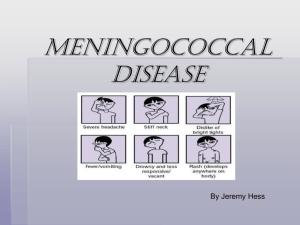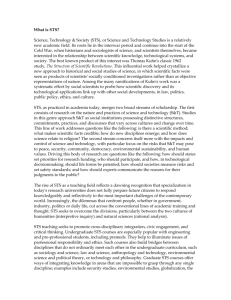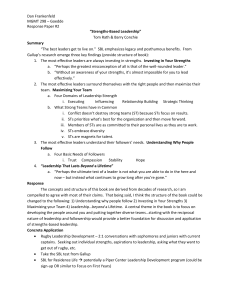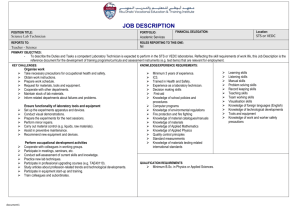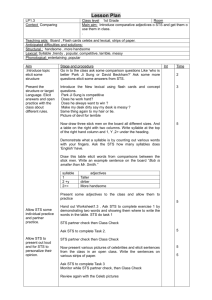Complex relatedness in the genus Neisseria
advertisement
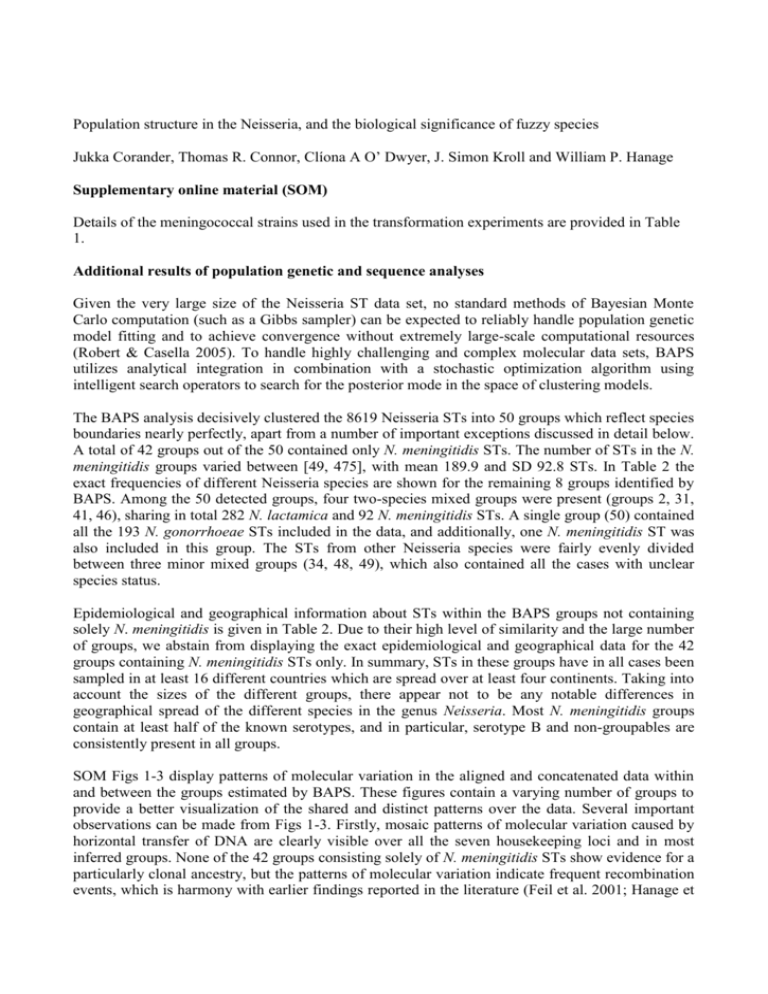
Population structure in the Neisseria, and the biological significance of fuzzy species Jukka Corander, Thomas R. Connor, Clíona A O’ Dwyer, J. Simon Kroll and William P. Hanage Supplementary online material (SOM) Details of the meningococcal strains used in the transformation experiments are provided in Table 1. Additional results of population genetic and sequence analyses Given the very large size of the Neisseria ST data set, no standard methods of Bayesian Monte Carlo computation (such as a Gibbs sampler) can be expected to reliably handle population genetic model fitting and to achieve convergence without extremely large-scale computational resources (Robert & Casella 2005). To handle highly challenging and complex molecular data sets, BAPS utilizes analytical integration in combination with a stochastic optimization algorithm using intelligent search operators to search for the posterior mode in the space of clustering models. The BAPS analysis decisively clustered the 8619 Neisseria STs into 50 groups which reflect species boundaries nearly perfectly, apart from a number of important exceptions discussed in detail below. A total of 42 groups out of the 50 contained only N. meningitidis STs. The number of STs in the N. meningitidis groups varied between [49, 475], with mean 189.9 and SD 92.8 STs. In Table 2 the exact frequencies of different Neisseria species are shown for the remaining 8 groups identified by BAPS. Among the 50 detected groups, four two-species mixed groups were present (groups 2, 31, 41, 46), sharing in total 282 N. lactamica and 92 N. meningitidis STs. A single group (50) contained all the 193 N. gonorrhoeae STs included in the data, and additionally, one N. meningitidis ST was also included in this group. The STs from other Neisseria species were fairly evenly divided between three minor mixed groups (34, 48, 49), which also contained all the cases with unclear species status. Epidemiological and geographical information about STs within the BAPS groups not containing solely N. meningitidis is given in Table 2. Due to their high level of similarity and the large number of groups, we abstain from displaying the exact epidemiological and geographical data for the 42 groups containing N. meningitidis STs only. In summary, STs in these groups have in all cases been sampled in at least 16 different countries which are spread over at least four continents. Taking into account the sizes of the different groups, there appear not to be any notable differences in geographical spread of the different species in the genus Neisseria. Most N. meningitidis groups contain at least half of the known serotypes, and in particular, serotype B and non-groupables are consistently present in all groups. SOM Figs 1-3 display patterns of molecular variation in the aligned and concatenated data within and between the groups estimated by BAPS. These figures contain a varying number of groups to provide a better visualization of the shared and distinct patterns over the data. Several important observations can be made from Figs 1-3. Firstly, mosaic patterns of molecular variation caused by horizontal transfer of DNA are clearly visible over all the seven housekeeping loci and in most inferred groups. None of the 42 groups consisting solely of N. meningitidis STs show evidence for a particularly clonal ancestry, but the patterns of molecular variation indicate frequent recombination events, which is harmony with earlier findings reported in the literature (Feil et al. 2001; Hanage et al. 2005; Zhou et al. 1997). SOM Fig 4 shows how the STs in BAPS groups 34, 48, 49 and 50 are distributed over the ML tree. Complete results of the BAPS admixture analysis are presented in Table 3 (see the separate Excel file). The estimates of admixture between the groups reported in Table 3 are calculated as in Tang et al. (2009). Analysis of possible species mis-classification and distribution of non-typable strains To consider to which extent a pattern of mixed clusters could emerge under the null hypothesis of equal mis-classification probability for all isolates, we calculated p-values for the observed frequencies of N. lactamica and N. meningitidis STs. Assuming that that the STs representing minority species in each mixed cluster were a result of laboratory error, the overall misclassification rate for any single ST is estimated to be 0.0319 and 0.0060 for N. lactamica (in total 282 STs) and N. meningitidis (in total 8074 STs), respectively. Under these two estimated frequencies as the null models of mis-classification for each ST, the corresponding p-values to observe frequencies of STs from a ‘wrong’ species that are at least as large as those reported in Table 1 can be calculated using the CDF of Binomial(n,θ) distribution, where n is the total number of STs in a group and θ is overall mis-classification rate for the species in question. The resulting pvalues are: <10-6, <10-15, 0.0065, 0.0017, for the groups 2, 31, 41, 46, respectively. The p-values remain clearly significant at 5% level even under a Bonferroni correction for multiple testing. Similar to the above analysis, we examined whether the increased proportion of non-typable meningococcus STs in groups 2, 31, 41, 46 can be reasonably explained by chance. Under the null hypothesis that the serotypes of the strains in each group represent a random sample of the observed population where non-typable STs are present with the overall frequency 21.2%, the Binomial pvalues of observing at least the number of non-typable STs as reported in Table 2 of the main article are: <0.0001 for groups 2, 31, 41 and 0.075 for group 46. Recombination between meningococcus and N. gonorrhoeae. The results display also evidence for recombination between the two pathogens in the dataset, N. gonorrhoeae and the meningococcus, for the STs residing in the mixed groups. The gdh and aroE genes show particularly clear traces of recombination in mixed N. lactamica and N. meningitidis groups, as well as to some extent also in the multi species group 34. To trace the possible origins of recombinations for gdh, we searched the NCBI nucleotide collection using the gdh sequence of a typical single N. meningitidis ST from each of the four mixed two-species groups. The BLAST results for group 2 are as follows: 100% match to appr. 10 N. gonorrhoeae sequences and a single N. lactamica sequence, whereas the closest match to a N. meningitidis sequence is only 91%. Similarly, for group 31 we obtained 98% match for the same N. gonorrhoeae and N. lactamica sequences as for group 2, while the degree of closest match to N. meningitidis remained unchanged. In contrast, for the two other mixed groups (41, 46), gdh sequences of N. meningitidis matched 100% to multiple N. meningitidis sequences present in the NCBI collection and no close matches to other species were discovered. Similarly, we repeated the search for origin for the latter part of the aroE gene, which shows evidence of multiple separate recombination events over the different groups. Here, a search at the NCBI nucleotide collection using N. meningitidis STs from the groups 2, 31 resulted in a 100% match with multiple N. gonorrhoeae, N. lactamica and N. meningitidis sequences. When comparable sequences of N. meningitidis STs from non-mixed groups were used in the search, they matched 100% to N. meningitidis, while no matches to other species were discovered. Finally, none of the 193 N. gonorrhoeae STs show any signs of horizontal import of DNA from the remaining lineages in the data. Tables and Figures Isolate OX9931639 OX01061662 ST99248587 ST00248061 89 295 584 M01, 257107 518 801 NG H15 90/18311 M99.241026 BZ 147 BZ 169 ST BAPS group 3260 3266 3270 4000 753 754 960 1186 860 861 43 11 4037 48 32 41 41 41 41 40 40 40 35 35 35 28 17 17 14 5 Assigned in a mixed BAPS group Yes Yes Yes Yes No No No No No No No No No No No Table 1. Meningococcal strains used in the transformation experiments. Variable\group Carrier Invasive Meningitis Disseminated gonococcal infection Uncomplicated gonorrhoea No. countries where sampled No. continents where sampled 2 61 (100.0%) 9 3 31 391 (99.4%) 1 (0.3%) 1 (0.3%) 22 4 34 17 (94.4%) 1 (5.6%) 6 3 41 25 (100.0%) 11 5 46 17 (63.0%) 7 (25.9%) 3 (11.1%) 13 4 48 15 (93.8%) 1 (6.2%) 16 4 49 6 (100.0%) 4 1 50 2 (2.2%) 10 (11.4%) 76 (86.4%) 24 6 Table 2. Epidemiological and geographical information about STs within the mixed BAPS groups. Percentages are given within parenthesis for the epidemiological status. Table 3. (separate Excel file). The estimates of admixture between the 50 BAPS groups. Diagonal values are put to zero and have no meaning. Figure 1. Inferred BAPS groups for 8619 STs of genus Neisseria. Each row corresponds to a concatenated MLST sequence for an ST and horizontal black lines indicate boundaries of the 50 clusters. Each column is a sequence position in the aligned data and colors indicate different nucleotides. An entirely white column corresponds to a monomorphic site. Figure 2. Two-species mixed BAPS groups 2, 31, 41 and 46 containing a total of 374 N. lactamica and N. meningitidis STs. Molecular variation is displayed analogously to Figure 1 but color coding may vary over the sites. Figure 3. The BAPS groups not containing solely N. meningitidis STs. Molecular variation is displayed analogously to Fig 1 but color coding may vary over the sites. Figure 4. ML tree for the 8619 STs with BAPS groups 34, 48, 49, 50 marked by colored branches. Figure 5. Boxplots of transformation frequencies for 27 replicates of the transformation experiments. Replicates 1-6 refer to experiments with meningococcal strains assigned to mixed BAPS groups (SOM Table 1) and the remaining replicates refer to strains in non-mixed groups. The three replicates with all observed transformation frequencies equal to zero (2 in the mixed and 1 in the non-mixed groups) are not included in the figure. Note that the non-displayed replicates were still included in the random effects analysis. Feil, E. J., Holmes, E. C., Bessen, D. E., Chan, M.-S., Day, N. P. J., Enright, M. C., Goldstein, R., Hood, D. W., Kalia, A., Moore, C. E., Zhou, J. & Spratt, B. G. 2001 Recombination within natural populations of pathogenic bacteria: short term empirical estimates and long-term phylogenetic consequences. Proceedings of the National Academy of Sciences USA 98, 182-187. Hanage, W. P., Fraser, C. & Spratt, B. G. 2005 Fuzzy species among recombinogenic bacteria. BMC Biol 3, 6. Robert, C. P. & Casella, G. 2005 Monte Carlo Statistical Methods. New York: Springer. Tang, J., Hanage, W. P., Fraser, C. & Corander, J. 2009 Identifying currents in the gene pool for bacterial populations using an integrative approach. PLoS Comput Biol 5, e1000455. Zhou, J., Bowler, L. D. & Spratt, B. G. 1997 Interspecies recombination, and phylogenetic distortions, within the glutamine synthetase and shikimate dehydrogenase genes of Neisseria meningitidis and commensal Neisseria species. Mol Microbiol 23, 799-812.

